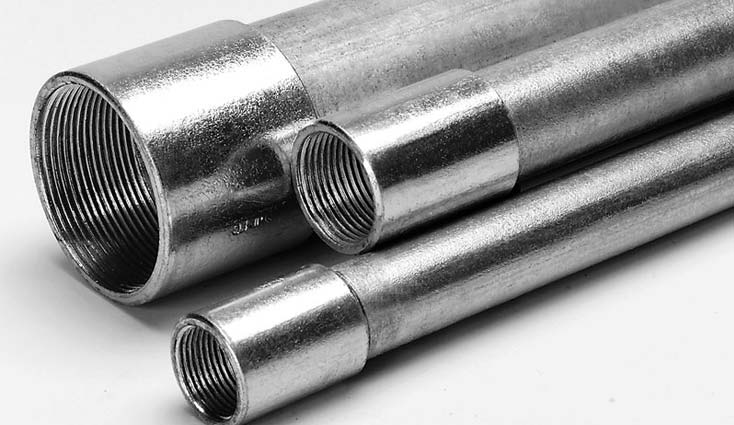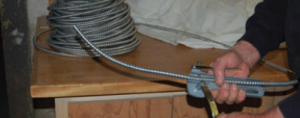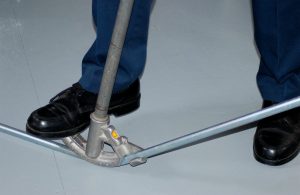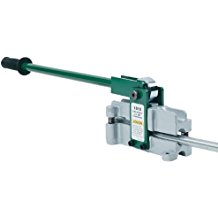Type MC and Type EMT Wiring Methods

By: David Herres | Apr 23, 2018
The wire of choice for feeders and branch circuits in residential locations is Type NM, non-metallic sheathed cable. It is inexpensive, quick and easy to use, and requires a minimum of tools. But its use is prohibited in sensitive locations, so for industrial, commercial, and even some residential locations, electrical designers and installers have to look elsewhere.
The 2017 National Electrical Code in Chapter 3, Wiring Methods and Materials, contains a complete list of cable types and raceways that are Code compliant. They are in Articles 320 through 399, and these are among the most frequently referenced. What makes them particularly user-friendly is that they all conform to a similar section numbering template, so once you learn it, accessing the information is very straight-forward.
Two worthwhile wiring methods are Type MC, metal-clad cable, and Type EMT, electrical metallic tubing. They are both intermediate in terms of material and installation cost- and also in permitted uses. You will find Uses Permitted and Uses Not Permitted for both in NEC Sections 330.10, 330.12, 358.10 and 358.12.

Type MC looks like the old BX (armor clad), which is no longer recognized as a wiring method. MC can have a smooth or corrugated metallic sheath or, most commonly, interlocking metal tape armor. The sheath may be steel or aluminum, which is non-magnetic and therefore suitable when used with a single conductor, so as to avoid an induced voltage on the sheath.
Type MC also resembles armored cable (Type AC) but there are some subtle differences. MC includes a green equipment-grounding conductor, whereas AC depends upon the outer sheath, with an internal continuous metal strip in contact with the sheath, for equipment grounding. For this reason, MC has a broader array of permitted uses.
Type MC is permitted for services, feeders and branch circuits, indoors or outdoors, exposed or concealed. It may be used in some, but not all classified locations. It is permitted in wet locations and underground where identified for such use.

Electrical Metallic Conduit (Type EMT) is technically a tubing, not a type of conduit, although electricians talk about “putting the wire in conduit” and it is understood that they mean EMT. It is a thin-wall tubing, aluminum, stainless steel, or usually steel with a protective coating.
Type EMT is suitable for branch circuits, feeders and services, and is used in sensitive areas such as elevator shafts and health-care facilities, and in some but not all classified areas. It is very widely used in commercial and industrial wiring, and for residential services. Compared to Rigid Metal Conduit (Type RMC), EMT is far less expensive and much easier to install. Segments can be marked with a fine-point felt-tipped pen and cut with a hacksaw, then reamed to remove sharp edges on the interior that could damage wire insulation.
Type EMT can be bent to make 90-degree sweeps and other angles including very common double-box offsets.

A simple hand conduit bender is necessary to prevent kinking and reduced internal cross-sectional area. Segments are easily joined used set-screw couplings and other fittings except for outdoor installations where compression fittings are required.
MC is also installed using simple tools. An MC cutter (Roto Splitter) is needed to cut the sheath with no danger of nicking the conductor insulation.
EMT and MC are often deployed in the same installation because their uses permitted are nearly identical. EMT has a better appearance for long exposed runs, while MC is good for fishing through wall and ceiling cavities, through drilled holes in framing members, and where complex, close-spaced bends would be difficult for EMT. It is not uncommon to see single branch-circuit runs that transition back and forth a dozen times between entrance panel and load.
It is very easy to transition between these two complementary wiring methods. Splices can be made in light fixture enclosures, wall boxes, or junction boxes. A 4 x 4 square box works well in an industrial setting. In-line splices without enclosures are not Code compliant, and of course, exposed wire nuts are prohibited.
To learn more about wiring methods, sign up for a JADE Learning electrical continuing education course.

